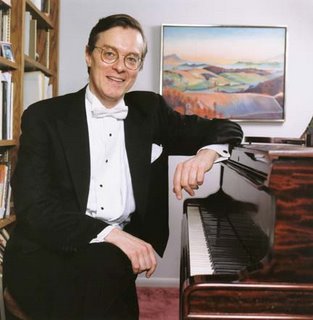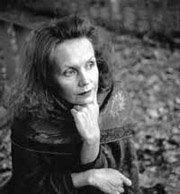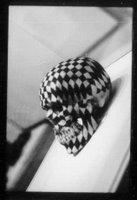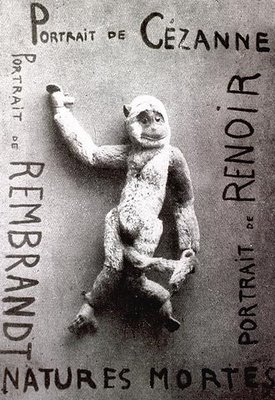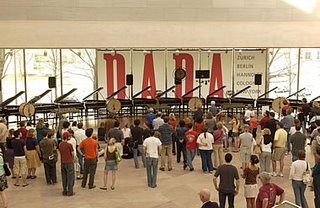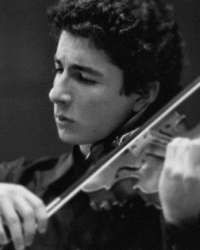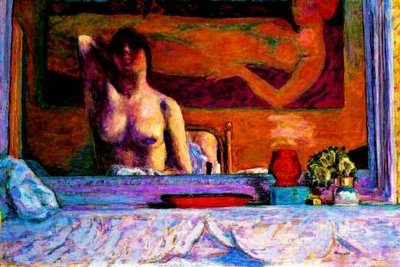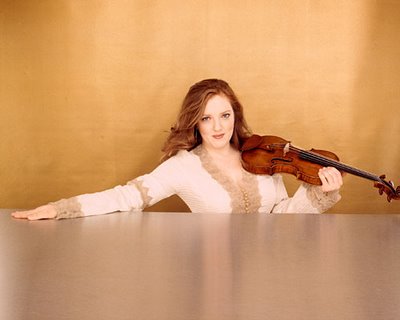Last month | Next monthClassical Month in Washington is a monthly feature that appears on the first of the month. If there are concerts you would like to see included on our schedule, send your suggestions by e-mail (ionarts at gmail dot com). Happy listening!Saturday, April 1, 5 and 8 pm; Sunday, April 2, 2 pm
Folger Consort: Landini and MachautFolger Shakespeare Library
Saturday, April 1, 7 pm; Tuesday, April 4, 7:30 pm; Thursday, April 6, 7:30 pm; Sunday, April 9, 2 pm
Donizetti, L'elisir d'amoreWashington National Opera
Kennedy Center Opera House
See the
review by Jens F. Laurson (Ionarts, April 3)
Saturday, April 1, 8 pm
Merce Cunningham Dance CompanyKennedy Center Eisenhower Theater
See the
review by Sarah Kaufman (
Washington Post, April 3)
Saturday, April 1, 8 pm
Yundi Li, pianoMusic by Mozart, Schumann, Chopin, and Liszt
Music Center at Strathmore
See the
review by George A. Pieler (Ionarts, April 3)
Sunday, April 2, 2 pm; Wednesday, April 5, 7:30 pm; Saturday, April 8, 7 pm; Monday, April 10, 7 pm; Friday, April 14, 7:30 pm
Wagner, Das RheingoldWashington National Opera
Kennedy Center Opera House
See the
review by Jens F. Laurson (Ionarts, March 26)
Sunday, April 2, 5 pm
Natasha Mah, piano
Phillips CollectionSunday, April 2, 6 pm
Rossini,
TancrediWashington Concert OperaLisner AuditoriumSee the
review by Jens F. Laurson (Ionarts, April 6)
Sunday, April 2, 6:30 pm
Kronos Quartet, with Wu Man, pipa player
Music by Rahul Dev Burman, Michael Gordon, Terry Riley, and John Zorn
National Gallery of Art (East Building Auditorium)
Sunday, April 2, 7:30 pm
Sequenza (piano trio)
Kennedy Center Terrace Theater (Fortas Chamber Music series)
Monday, April 3, 7:30 pm
All Copland (part of
President's Festival of the Arts 2006)
CUA Symphony Orchestra
Church of the Epiphany (13th and G Streets NW)
See the
review by Daniel Ginsberg (
Washington Post, April 5)
Tuesday, April 4, 12:10 pm
Noontime Cantata:
Tue Rechnung! Donnerwort, BWV 168
Washington Bach Consort
Church of the Epiphany (13th and G Streets NW)
Tuesday, April 4, 7:30 pm
Chamber Music: All Copland (part of
President's Festival of the Arts 2006)
Ivo Kaltchev, Rome Trio, Sharon Christman
Pryzbyla Center, Catholic University
Tuesday, April 4, 8 pm
Yo-Yo Ma, cello (WPAS)
Solo cello suites by J. S. Bach
Kennedy Center Concert Hall
See the
review by Jens F. Laurson (Ionarts, April 7)
Wednesday, April 5, 7:30 pm
New Old American Songs (part of
President's Festival of the Arts 2006)
CUA Chorus
Pryzbyla Center, Catholic University
Wednesday, April 5, 8 pm
Academy of Ancient Music (Giuliano Carmignola, director)
All-Mozart program
Clarice Smith Performing Arts Center (College Park, Md.)
Thursday, April 6, 7:30 pm
Irwin Shaw's
Quiet City (part of
President's Festival of the Arts 2006)
Semi-staged reading with music by Aaron Copland (CUA Chamber Ensemble)
Pryzbyla Center, Catholic University
Thursday, April 6, 8 pm
Turtle Island String Quartet [FREE, and no ticket required]
Library of CongressThursday, April 6, 8 pm
Baltimore Symphony Orchestra: Monet and the Impressionists, with conductor Jahja Ling
Music by Debussy, Ravel, and Beethoven (Third Symphony)
Music Center at Strathmore
See the
review by Tim Smith (
Baltimore Sun, April 8)
Friday, April 7, 7:30 pm; Saturday, April 8, 7:30 pm
Aaron Copland,
The Tender Land (chamber version) (part of
President's Festival of the Arts 2006)
Pryzbyla Center, Catholic University
See the
review by Cecelia Porter (
Washington Post, April 10)
Friday, April 7, 8 pm
Juilliard String Quartet [FREE]
Music by Schubert, Viñao, and Beethoven
Library of CongressFriday, April 7, 8 pm
Krystian Zimerman, pianoShriver Hall (Baltimore, Md.)
See the
review by Jens F. Laurson and Charles T. Downey (Ionarts, April 8)
Friday, April 7, 8 pm; Saturday, April 8, 8 pm
Reto Reichenbach, pianoMusic by Martin, Brahms, Franck
Embassy of Switzerland (2900 Cathedral Avenue NW)
See the
review by George A. Pieler (Ionarts, April 8)
Friday, April 7, 8 pm; Sunday, April 9, 2 pm
Bellini, NormaVirginia Opera
George Mason University Center for the ArtsSee the
review by Grace Jean (
Washington Post, April 10) and the
review by T. L. Ponick (
Washington Times, April 11)
Saturday, April 8, 2 pm
Malcolm Bilson, lecture/piano recitalPerforming on a replica of the 1814 Nanette Streicher piano
Baltimore Museum of Art
See the
review by Jens F. Laurson (Ionarts, April 9)
Saturday, April 8, 8 pm
Leon Fleisher, pianoMusic by Bach (Capriccio in B-flat major, BWV 992, and Chromatic Fantasy and Fugue), Stravinsky (Serenade for Piano in A Major), and Schubert (Sonata in B-flat, D. 960)
Shriver Hall (Baltimore, Md.)
See the
review by Jens F. Laurson (Ionarts, April 11)
Saturday, April 8, 8 pm
Lent in Leipzig (music by Keyser, Kuhnau, J. S. Bach)
Cantate Chamber SingersSt. John’s Norwood Parish (Chevy Chase, Md.)
Saturday, April 8, 8 pm
Elmar Oliveira, violin [FREE]
Library of CongressSaturday, April 8, 8 pm [free masterclass at 1 pm]
Pacifica Quartet
Music by Mendelssohn, Janáček, Tchaikovsky
Kreeger Museum Saturday, April 8, 8 pm
National Philharmonic, with Cho-Liang Lin, violinMusic by Beethoven and Mussorgsky
Music Center at Strathmore
Sunday, April 9, 3 pm
Fazil Say, pianoMusic by Bach (Prelude and Fugue in A minor, BWV 543, and Busoni's arrangement of the D minor chaconne from the second violin partita), Beethoven (Tempest sonata), and Stravinsky (Rite of Spring for piano, four hands)
Shriver Hall (Baltimore, Md.)
See the
review by Jens F. Laurson and Charles T. Downey (Ionarts, April 12)
Sunday, April 9, 3 pm
Washington Chorus: William Walton, Belshazzar's Feast, and motets and Gloria by PoulencKennedy Center Concert Hall
See the
review by Robert R. Reilly (Ionarts, April 10)
Sunday, April 9, 6:30 pm
Eusia String Quartet, with James Dick, pianist
Music by Debussy, Fauré, and Gregory Vajda
National Gallery of ArtSunday, April 9, 7:30 pm
Courtenay Budd, soprano
Jewish Community Center of Greater Washington (Rockville, Md.)
Monday, April 10, 7:30 pm
Diotima String Quartet
Hosokawa,
Silent Flowers; Berg,
Lyric Suite; Webern,
Six Bagatelles, op. 9; Ferneyhough,
Quartet No. 2; Janáček,
Quartet No. 2La Maison Française (4101 Reservoir Road NW)
Request a reservation by sending an e-mail to Culturel.WASHINGTON-AMBA@diplomatie.gouv.fr
See the
review by Charles T. Downey (Ionarts, April 12)
Thursday, April 13, 7 pm; Friday, April 14, 1:30 pm; Saturday, April 15, 8 pm
National Symphony Orchestra, St. Matthew Passion, with Helmuth RillingKennedy Center Concert Hall
See the
review by Jens F. Laurson (Ionarts, April 14)
Thursday, April 13, 8 pm
Lang Lang, piano (WPAS)
Music Center at StrathmoreSee the
review by George A. Pieler (Ionarts, April 15)
Friday, April 14, 8 pm
Choral Arts Society of WashingtonMusic Center at Strathmore
See the
review by Jens F. Laurson (Ionarts, April 17)
Saturday, April 15, 8 pm
Left Bank Concert Society: Shades of Our TimesMusic by Moravec, Dutilleux, Ewazen, Stucky, and Bartók (String Quartet No. 5)
Clarice Smith Performing Arts Center (College Park, Md.)
See the
review by Cecelia Porter (
Washington Post, April 17)
Sunday, April 16, 5 pm
Haskell Small, piano
World premiere of commissioned composition:
Renoir’s FeastPhillips CollectionSee the
review by Joan Reinthaler (
Washington Post, April 18)
Monday, April 17, 8 pm
National Symphony Orchestra/JCC Chamber Music Series
Jewish Community Center of Greater Washington (Rockville, Md.)
Thursday, April 20, 7 pm; Friday, April 21, 8 pm; Saturday, April 22, 8 pm
National Symphony Orchestra: Rafael Frühbeck de Burgos, conductor/Julian Rachlin, violinMusic by Beethoven (Sixth Symphony), Prokofiev (second violin concerto), and Stravinsky (Firebird Suite)
Kennedy Center Concert Hall
See the
review by Jens F. Laurson (Ionarts, April 21)
Thursday, April 20, 7:30 pm
Garth Newel Piano QuartetMansion at Strathmore
Thursday, April 20, 8 pm; Friday, April 21, 8 pm
Mendelssohn Piano Trio with Michael Stepniak (viola) and Claudia Chudacoff (cello)Robert Schumann Festival
Embassy of the Federal Republic of Germany (4645 Reservoir Road NW)
Thursday, April 20, 5 pm
Alex Ross (of
The New Yorker and The Rest Is Noise), “Hitler and Stalin as Music-Lovers”
Peabody Musicology Colloquium
Cohen-Davison Theatre at Peabody (Baltimore, Md.)
See the
calamity summary by Charles T. Downey (Ionarts, April 22)
Friday, April 21, 7:30 pm; Sunday, April 23, 3 pm; Tuesday, April 25, 7:30 pm; Thursday, April 27, 7:30 pm; Saturday, April 29, 7:30 pm; Sunday, April 30, 3 pm
Cimarosa, Il Matrimonio SegretoUniversity of Maryland Opera Studio, conducted by Ryan Brown
Clarice Smith Performing Arts Studio (College Park, Md.)
See the
review by Charles T. Downey (Ionarts, April 28)
Friday, April 21, 8 pm
Washington Bach Consort [FREE]
Bach's Cantata
Es ist das heil uns kommen her, BWV 9, and twentieth-century choral works by American composers
Library of CongressSee the
review by Joe Banno (
Washington Post, April 24)
Friday, April 21, 8 pm
Trio Solisti with David Krakauer, clarinetMusic by Moravec
Barns at Wolf Trap (Vienna, Va.)
See the
review by Cecelia Porter (
Washington Post, April 24)
Saturday, April 22, 4:30 pm
San Francisco Symphony Orchestra, with Michael Tilson Thomas, conductor (WPAS)
Music by Debussy,
Berg Ravel, Mahler, and Wagner
Lulu Suite, with soprano Celena ShaferReplaced by Jean-Yves Thibaudet, Ravel's Piano Concerto in D Major for Left Hand
Kennedy Center Concert Hall
See the
review by Jens F. Laurson (Ionarts, April 26)
Saturday, April 22, 8 pm
National Philharmonic, with Philip Hosford, pianoMusic by Haydn, Salieri, and Mozart
Music Center at Strathmore
See the
review by Mark J. Estren (
Washington Post, April 24)
Saturday, April 22, 8:30 pm; Sunday, April 23, 7:30 pm
Jerusalem Quartet
Jewish Community Center of Greater Washington (Rockville, Md.)
See the
review by Charles T. Downey (Ionarts, April 24)
Sunday, April 23, 3 pm
The Master Chorale of WashingtonMusic by Copland and world premiere by Hailstork
Kennedy Center Concert Hall
See the
review by Tim Page (
Washington Post, April 25)
Sunday, April 23, 4 pm
Verdi,
RequiemNew Dominion ChoraleRachel M. Schlesinger Concert Hall (Alexandria, Va.)
See the
review by Mark J. Estren (
Washington Post, April 26)
Sunday, April 23, 4:30 pm
Contemporary Music ForumMusic by Frederick Weck, Douglas Boyce, Steve Antosca, and Miroslav Pudlak
Corcoran Gallery of Art
See the
review by Daniel Ginsberg (
Washington Post, April 26)
Sunday, April 23, 5 pm
Gregory Sioles with Marcolivia, piano trio
Phillips CollectionSunday, April 23, 6:30 pm
Piotr Andrszewski, pianist
Music by Bach, Mozart, and Karol Szymanowski
National Gallery of ArtSee the
review by Jens F. Laurson (Ionarts, April 27)
Monday, April 24, 7:30 pm
Ensemble Doulce Mémoire17th-century French music, with Baroque dance
La Maison FrançaiseSee the
review by Charles T. Downey (Ionarts, April 26)
Monday, April 24, 8 pm
Itzhak Perlman, violin, and Pinchas Zukerman, violin/viola (WPAS)
Kennedy Center Concert Hall
See the
review by Jens F. Laurson (Ionarts, April 28)
Tuesday, April 25, 7:30 pm
Efe Baltacigil, cello (WPAS)
Kennedy Center Terrace Theater
See the
review by Jens F. Laurson (Ionarts, April 29)
Wednesday, April 26, 7:30 pm
Shanghai Quartet [FREE]
Bartók, first string quartet; Ravel, Quartet in F; Yi-wen Jiang, ChinaSong
Freer Gallery of ArtSee the
review by Jens F. Laurson (Ionarts, May 2)
Thursday, April 27, 7 pm; Friday, April 28, 8 pm; Saturday, April 29, 8 pm
National Symphony Orchestra: Mstislav Rostropovich, conductor/Dawn Upshaw, sopranoMusic by Bernstein (Slava! [A Political Overture]), Britten (Peter Grimes Sea Interludes), Dutilleux (Correspondances, 2003), and Dvořák (Eighth Symphony)
Kennedy Center Concert Hall
See the
review by Jens F. Laurson (Ionarts, April 28)
Thursday, April 27, 8 pm; Friday, April 28, 8 pm; Sunday, April 30, 3 pm
Baltimore Symphony Orchestra, with conductor Carlos KalmarProgram includes John Adams,
On the Transmigration of SoulsConcert Artists of Baltimore Symphonic Chorale and Peabody Children's Chorus
Meyerhoff Symphony Hall (Baltimore, Md.)
See the
review by Charles T. Downey (Ionarts, April 29)
Friday, April 28, 7 pm
Georgetown University Chamber Singers, “Sing Joyfully”
Byrd’s “Mass for Four Voices”, “Ave Verum Corpus,” and “Sing Joyfully”
Dumbarton United Methodist Church (3133 Dumbarton Street NW)
Friday, April 28, 7:30 pm
East Coast Chamber OrchestraKennedy Center Terrace Theater
See the
review by Mark J. Estren (
Washington Post, May 1)
Friday, April 28, 7:30 pm
Antoine Tamestit (viola) and Alexis Descharmes (cello)
Contemporary, mostly Hungarian music
La Maison FrançaiseFriday, April 28, 8 pm
London Haydn Quartet, with Eric Hoeprich, clarinet [FREE]
All-Mozart program: Clarinet Quartet in B-flat Major (18th-c. arr. of Violin Sonata, K. 378), String Quartet in F Major, K. 590 ("Prussian"), Fugues in C minor and D Major for string quartet, K. 405 (arr. of BWV 871 and 874), and Clarinet Quintet in A Major, K. 581
Library of CongressSee the
review by Stephen Brookes (
Washington Post, May 1)
Friday, April 28, 8 pm
Weilerstein TrioAll-Dvořák program
Corcoran Gallery of Art
Saturday, April 29, 4:30 pm
Ute Lemper, vocalist [CANCELLED]
Cabaret concert, presented in honor of Dada
National Gallery of Art (East Building Auditorium)
Saturday, April 29, 5 pm
21st Century Consort, with soprano Lucy Shelton
Tom Flaherty, When Time Was Young; Jacob Druckman, Lamia; Jon Deak, Rapunzel
Hirshhorn Museum
Saturday, April 29, 8:15 pm; Wednesday, May 3, 7:30 pm; Friday, May 5, 8:15 pm; Sunday, May 7, 3 pm
Puccini,
La BohèmeBaltimore Opera
See the
review by Grace Jean (
Washington Post, May 1)
Sunday, April 30, 3 pm
Metropolitan ChorusMusic by Vaughan Williams, Tchaikovsky, and Luis Bacalov (
Misa Tango)
Rachel M. Schlesinger Concert Hall and Arts Center (Alexandria, Va.)
Sunday, April 30, 5 pm
Christopher Guzman, piano
Phillips CollectionSunday, April 30, 6:30 pm
Modern Musick
Music by Charles Avison, Handel, Locke, Purcell, Vivaldi, and other composers, played on period instruments
National Gallery of ArtSunday, April 30, 7:30 pm
Russian Chamber Art Society
Galina Sakhnovskaya (soprano), Timothy Mix (baritone), with Tamara Sanikidze and Mikhail Yanovitsky (piano)
Vocal music by the Mighty Five
The Lyceum (Alexandria, Va.)
See the
review by Mark J. Estren (
Washington Post, May 2)
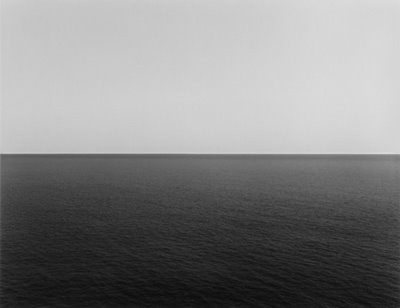 In creating this music, Chartier and Deupree were inspired by the Seascapes series of photographs made by Hiroshi Sugimoto, in response to a desire to view natural sites as primitive man might have seen them. To make these 13 large-format photographs (and four smaller ones), he traveled to seashores around the world and photographed only water and sky at the site, with no other object or person or animal in them. In most of them, the horizon line is placed right at the center of the photograph, so that the frame is equal parts light sky and dark water. The room in which they are shown is cavernous and dark, with spotlights on the photographs, assisting in Sugimoto's ritualistic plan.
In creating this music, Chartier and Deupree were inspired by the Seascapes series of photographs made by Hiroshi Sugimoto, in response to a desire to view natural sites as primitive man might have seen them. To make these 13 large-format photographs (and four smaller ones), he traveled to seashores around the world and photographed only water and sky at the site, with no other object or person or animal in them. In most of them, the horizon line is placed right at the center of the photograph, so that the frame is equal parts light sky and dark water. The room in which they are shown is cavernous and dark, with spotlights on the photographs, assisting in Sugimoto's ritualistic plan. 